Verräter
Verraeter (Originalregel)
Préparation du Jeu
3 à 4 joueurs peuvent participer à une partie en tapant /join . Démarrez le jeu avec /start . Il est aussi possible d'utiliser les raccourcis de l'outil Jeu.
Le jeu
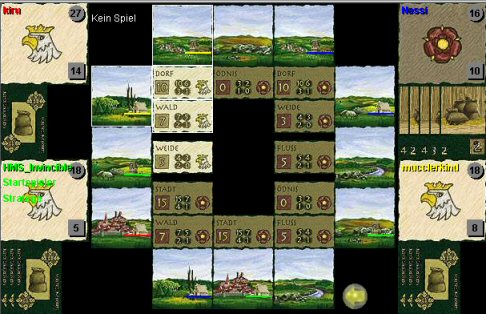
Deux maisons princières aux opinions contraires se combattent : l'Aigle et la Rose. Les joueurs combattent pour les maisons princières et essaient de conquérir des régions adverses et ainsi gagner des points de victoire. La maison pour laquelle on combat peut changer au cours du jeu, car en chacun se cache un petit traitre...
Plateau de jeu
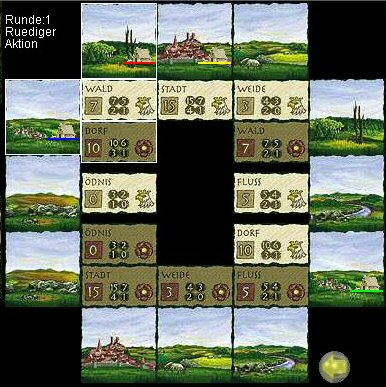
Au centre se trouvent les régions des deux camps Aigle et Rose. Au début les deux partis ont les mêmes régions.
Chaque carte région contient un grand nombre d'informations :

- La couleur et le symbole indiquent le ralliement
- Le nombre dans le carré est le nombre de points de conflit (voir ci dessous)
- Les petits nombres dans les cercles indiquent le nombre de point de victoire (voir ci dessous)
Les informations des joueurs sont disposées autour du plateau de jeu.
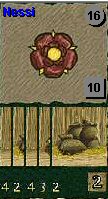
On connait la couleur et le symbole du ralliement actuel d'un joueur. En haut à droite sont affichés ses points de victoire, en bas à droite la somme des cartes ressources qu'il a joué en phase 3. En dessous on peut voir ses propres cartes richesses, qui sont cachées aux autres joueurs.
En haut à gauche on peut voir l'affichage du statut.

On peut y voir le numéro du tour actuel, le joueur actif et l'action qu'il doit faire à ce moment là.
Déroulement du jeu
A 3/4 joueurs le jeu se déroule en 9/8 tours qui se décomposent chacun en douze phases.
Au début du jeu chaque joueur reçoit trois cartes richesses avec les valeurs 3/4/5. Le premier joueur est déterminé et le joueur suivant le premier joueur est automatiquement désigné Stratège pour le premier tour. L'ordre des joueurs est quelque peu différent par rapport aux autres jeux : en haut à gauche - en bas à gauche - en haut à droite - en bas à droite ; c'est toujours le premier joueur qui commence, il avance d'une place à chaque tour.
Ensuite chaque joueur pose dans l'ordre un grenier.
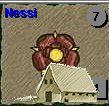
Il faut faire attention que le grenier doit être dessiné dans sa propre zone (avec son nom). Si un comptoir est affiché, il est possible de le changer en cliquant dessus. Il faut alors choisir une case de paysage (de préférence de son camp) et y placer son grenier.
Phase 1 - Déterminer le lieu du conflit
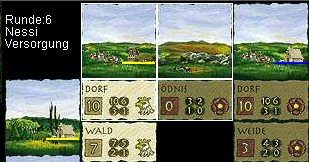
Le joueur qui a choisit le stratège au tour précédent, peut maintenant choisir le lieu du conflit ; c.-à-d. qu'il choisit deux territoires voisins de camp opposé. Pour cela il doit placer la souris sur les territoires : les deux territoires voisins sont toujours indiqué par un cadre blanc (dans l'exemple Dorf Aigle et Ödnis Rose). Lorsque les deux territoires choisis sont encadrés de blanc, il doit valider le choix en cliquant.
Phase 2 - Choisir une carte action
Il existe six cartes action :
Le stratège

Le joueur qui prend le stratège sera stratège au prochain tour et pourra fixer le lieu du conflit. Il obtient deux points de victoire à ce tour.
Le paysan

Le paysan reçoit trois cartes richesses à la phase 10.
L´architecte

Le bâtisseur peut construire un nouveau grenier ou comptoir ou transformer un grenier en comptoir et inversement.
Le diplomate 5

Le diplomate 5 apporte cinq points de conflit dans la bataille.
Le diplomate 2

Le diplomate 2 apporte deux points de conflit dans la bataille. De plus il rapporte une carte richesse supplémentaire en phase 10.
Le traitre

Le traitre change son ralliement et combat pour la maison adverse. Il reçoit un point de victoire.
A chaque tour une carte action est secrètement retirée. En commençant par le premier joueur chaque joueur choisit une des cartes action restante.
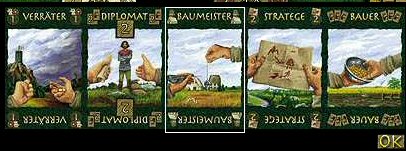
Il faut cliquer sur la carte action souhaitée et valider avec "OK".
Parfois la fenêtre s'affiche n'importe où sur l'écran. Il est possible de saisir le bord de la fenêtre avec la souris et la ramener au centre de l'écran.
Phase 3 - Jouer les cartes richesses
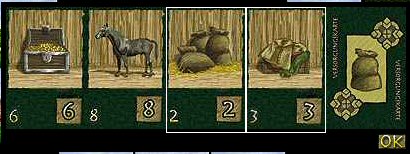
En commençant par le premier joueur, chaque joueur place face visible de 0 à 5 cartes richesses, pour augmenter la force de la région de son camp. Pour cela il faut cliquer sur toutes les cartes que l'on souhaite jouer. Elles sont marquées par un cadre blanc. Enfin il faut valider son choix en cliquant sur "OK".
Il existe au total 23 cartes richesses (5x2, 5x3, 5x4, 5x5, 2x6, 1x8)
Phase 4 - Découvrir les cartes action
Maintenant toutes les cartes actions sont révélées. S'il y a un traitre en jeu, celui-ci change de camp et supporte l'autre maison.
Phase 5 - Résoudre le conflit
Les points de conflit des deux maisons princières sont comparés. Pour cela on compte :
- les points de conflit de la région impliquée
- les cartes richesses jouées (les cartes du traitre comptent maintenant pour sa nouvelle maison !)
- les points de conflit des deux diplomates (5 ou 2)
La maison princière avec le plus grand total de point de conflit gagne. Si les deux maisons princières obtiennent le même nombre de points de conflit aucun point de victoire n'est attribué pour la victoire. Mais les points de victoire pour le traitre (1) et le stratège (2) sont comptés dans tous les cas.
Phase 6 - Distribuer les points de victoire

Les points de victoires de la carte région de la maison vaincue sont donnés aux joueurs qui ont soutenu la maison victorieuse. Le nombre de point de victoire gagné par chaque joueur dépend du nombre de joueurs dans le camp de la maison victorieuse.
Dans l'exemple (Dorf) si la maison victorieuse n'est soutenue que par un seul joueur, celui-ci serait récompensé par dix points. S'ils étaient deux chacun recevrait six points et à trois trois points. Si tous les joueurs sont dans le même camp, chaque joueur ne reçoit qu'un point.
De plus le traitre reçoit un point de victoire, le stratège deux.

Le territoire vaincu retourne son allégeance. Le blason de la maison victorieuse est affiché au centre du plateau de jeu. Pour continuer chaque joueur doit cliquer sur le blason. Ainsi chacun a le temps et la possibilité de regarder calmement le tour.
Phase 7 - conduire l'action du bâtisseur
Le bâtisseur peut maintenant construire un nouveau grenier ou comptoir ou convertir un comptoir en grenier et inversement ; il est également possible de déplacer un bâtiment.


Pour cela il faut d'abord choisir dans l'affichage avec son nom si l'on souhaite construire un grenier ou un comptoir. Un clic sur le bâtiment change d'un type en l'autre. Il faut alors choisir par un clic de souris sur le territoire sur lequel le bâtiment doit être placé. Il faut faire attention au fait que les greniers ne peuvent rapporter de cartes richesses que lorsqu'ils sont sur une case de son propre camp.
S'il l'on souhaite déplacer un bâtiment, il faut d'abord cliquer sur le bâtiment, fixer ensuite le type de bâtiment voulu et le replacer.

Les bâtiments sont signalés sur les cases territoires avec une ligne colorée dans la couleur du joueur. Un joueur peut avoir au maximum trois bâtiments et un maximum de deux comptoirs.
Phase 8 - Conduire l'action du stratège
Celui qui a pris le rôle du stratège reçoit maintenant le titre et a ainsi le droit de choisir le lieu du conflit au prochain tour. Un joueur garde ce rôle tant que la carte action stratège n'a pas été choisie par un autre joueur. Les deux points de victoire supplémentaire pour le stratège ne sont cependant donnés que lorsqu'il a choisit cette carte action à ce tour.
Phase 9 - Défausser les cartes richesses
Les cartes richesses qui ont été utilisées dans le conflit vont dans la pile de défausse.
Phase 10 - Piocher des cartes richesses
Le paysan reçoit toujours trois cartes richesses. Tous les autres joueurs en commençant par le premier joueur piochent alors une carte richesse pour chaque grenier sur un territoire de son propre camp. Le joueur avec la carte action diplomate 2 reçoit une carte richesse supplémentaire.
Attention au point suivant : aucun joueur ne peut recevoir plus de trois cartes et aucun ne peut avoir plus de cinq cartes en main ! Un paysan ne reçoit donc par exemple aucune carte supplémentaire pour ses greniers car il a déjà reçu trois cartes pour sa carte action "Paysan".
Phase 11 - Rendre les cartes action
Les cartes action sont récupérées et préparées pour le prochain tour.
12 - Changement de premier joueur
Le joueur, qui dans l'ordre joue après le premier joueur actuel, devient maintenant premier joueur et le jeu recommence en phase 1.
Les phases sans interaction avec les joueurs, par exemple dans lesquelles seuls les points sont comptés ou les cartes rendues sont effectuées automatiquement par le programme (Phase 4, 5, 6, 8, 9, 11 et 12).
Fin de la partie
Le jeu se termine après la phase 10, soit lorsqu'une maison princière a gagné tous les territoires ou à 3/4 joueurs après 9/8 tours.
Les points pour les comptoirs sont comptabilisés comme suit : chaque joueur multiplie le nombre de ses comptoirs (quel que soit l'endroit où ils se trouvent) par le nombre de leurs cartes richesses. Mais seuls trois cartes richesses peuvent être prises en compte au maximum. Comme l'on peut construire deux comptoirs au maximum, le nombre de points supplémentaire que l'on peut obtenir au mieux est 2 * 3 = 6. Ces points sont ajoutés aux points de victoires gagnés pendant la partie. Celui qui a alors le plus de points de victoire gagne la partie.

